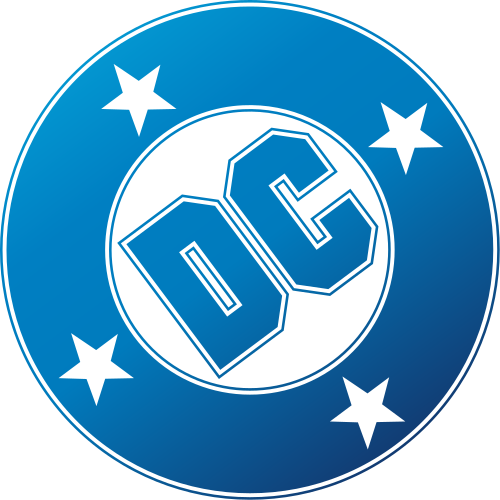History
Creation
The original concept of Batman was developed by writer/artist Bob Kane. Inspired by Sherlock Holmes, Zorro, a Leonardo da Vinci sketch of a bat-winged flying machine, and his own imagination, Kane sketched an early version of the character.
Taking his idea to writer Bill Finger, they further developed the concept. Finger himself said on more than one occasion that Kane did indeed create a version of the character before Finger got involved with the project. Kane was inspired by the flying machine of Leonardo Da Vinci, a movie he had seen called The Bat and of course, Bela Lugosi's 1931 film Dracula which featured a "man-bat" in its opening credits. However, Finger did suggest a different costume direction for "The Bat-Man."

In an interview for Jim Steranko's History of the Comics: Vol. One, Finger described in detail, the extent of his suggestions about the costume. He felt the original character (The Bat-Man) looked too much like Superman with a mask and bat-wings. He recommended replacing the Da Vinci-inspired wings with a cape, giving him gloves, and changing the character's bodysuit from red to grey. Perhaps most importantly, Finger found a book with a picture of a bat in it and encouraged Kane to replace the character's domino mask with a more bat-like hooded cowl, complete with "ears" which would make the character distinguishable even in silhouette. It's generally agreed that Finger encouraged Kane to leave out the character's eyes when he wore the mask. Although Kane would accept many of these suggestions, one cannot escape the direct influence of Lee Falk's character The Phantom, as Kane admitted that he studied newspaper strips on a routine basis.
Finger wrote the first Batman script, while Kane provided art. Because Kane had already submitted the proposal for a Batman character to his editors at DC Comics, Kane was the only person given official credit at the time for the creation of Batman. This was not unusual in the comic books of that time, where the artist would often sign his name to the first page of the story and the script would be uncredited, but it was in contrast to other features on which Finger worked where he was identified as scripter, such as Wildcat and Green Lantern, and in contrast to the credits on features by the same publisher such as Superman, where writer Jerry Siegel and artist Joe Shuster both received credit during the time they were affiliated with the publisher, even on stories ghosted for them by other writers and artists.
According to Wizard Magazine, Bob Kane had Finger enter a work for hire contract. It is this contract that provided National and DC their strongest defense against later claims by Finger.
Finger was a very meticulous writer and as such, a slow one, leading editor Whitney Ellsworth to "suggest" that Kane replace him with someone else. During Finger's absence, Gardner Fox contributed scripts that introduced Batman's early "Bat-" arsenal (the utility belt, the Bat-Gyro/plane and the Batarang). Upon his return, Finger created or co-created items such as the Batmobile and Batcave, and is credited with providing a name for Gotham City. Among the things that made his stories particularly distinctive was a use of giant-sized props: enlarged pennies, sewing machines, or typewriters.
Kane and Finger brought together such diverse influences as pulp magazines, comic strips, film noir, and the slapstick comedy of teams like the Marx Brothers and the Three Stooges, creating a "Cartoon-Noir" that was widely imitated. Eventually, Finger left Kane's studio to work directly for DC Comics where he still supplied scripts for Batman as well as many other characters.
Supporting Characters and Villains
Batman was featured in solo adventures for nearly the first year since his creation. It was then that Kane and Finger decided to introduce a new character. Finger, who was the regular writer of the Batman comic, would find it difficult to write the stories when the main character had nobody to talk to, and thus, they decided to create a partner for Batman. Robin was introduced in 1940 and he remained a constant character for the rest of Batman's history.
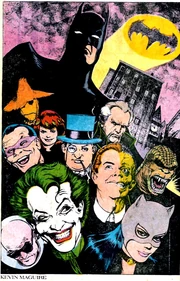
Soon after Robin's introduction, many other characters were introduced to the Batman history, but instead of being supporting characters, they were all villains. Characters like Joker, Catwoman and Hugo Strange debuted immediately after this. For years, these characters remained as the main cast, and they were soon followed by others like Penguin, Riddler, Two-Face, Scarecrow and many other minor characters like Alfred Pennyworth.
Batman and his supporting cast remained unchanged for years until the late 1950s, in which many colorful characters were introduced. Among them were Batwoman, Ace the Bat-Hound, Bat-Girl, Bat-Mite and several others that were created as caricatures of the main concept of Batman. However, their existence was short lived and they were soon eliminated from the history of Batman.
Evolution
In 1964, DC Comics introduced the "New Look" of Batman. His costume was changed in order to feature a yellow oval/circle surrounding the Bat insignia on the Batsuit. This new appearance also marked the change of direction in the Batman stories, which had been based around science-fiction and fantasy elements. The new stories featured a more serious context and they were often presented as mysteries and detective stories, as they did in the early days.
A couple of years later, in 1966, the notorious Batman TV Show premiered on national television and the popularity of Batman increased to levels that were never reached before. As a result of the TV show, Batman was changed once again and became a friendlier version of himself. Unfortunately, the popularity of the Batman TV Show didn't last long and in 1968 it was cancelled. In 1970, Batman was transformed into a dark figure of the night and his stories were based around murder mysteries and thrillers, However and despite this changes, the general public was no longer interested in the character and the Batman comic book reached historical low selling numbers in 1985.
In 1986, writer Frank Miller developed dark version of Batman as an elder hero who returns to action after years of retirement. Batman: The Dark Knight Returns was set outside of the main DC Universe continuity and it became the graphic novel that defined the Batman for the new generations. This version was much more psychologically complex, dark, gritty and based on real situations which made Batman a more feasible character. Soon, Miller was assigned to write the new origin for Batman in the regular continuity in Batman: Year One. In 1988, writer Alan Moore created the shocking graphic novel Batman: The Killing Joke, which further defined Batman as a dark, menacing figure as well as Joker's title of Batman's arch-nemesis.
Not long after this, Batman returned to the screens, but this time under Tim Burton's direction. The Batman film of 1989 was a complete success and Batman became once again, one of the most popular figures in pop culture. After the success of the film, a new TV series started production and Batman: The Animated Series made its debut in 1992. It was around this time that new characters were introduced into the Batman history. Bane was a new villain, who was capable of defeating Batman with catastrophic consequences. Harley Quinn was another new character, who was adapted from the Animated Series, due to her extreme popularity.
In the early 2000, a new film franchise was developed by Christopher Nolan and Batman Begins revitalized the films of the Dark Knight. It's success allowed Nolan to develop the critically acclaimed sequels The Dark Knight and The Dark Knight Rises. A few years later, the Batman: Arkham Asylum video game was released and became the most successful super-hero video game along with it's sequel, Batman: Arkham City.
As his legacy keeps growing, Batman remains a mainstay figure for DC Comics as he has become the comic book character with the most films, TV series and videogames as well thousands of comics and hundreds of interpretations.
Comics
Batman is one of the comic book characters with the largest history in comic books. He was created in 1939, during the so-called Golden Age of comics and his books have remained in publication to the present date without interruption.
Golden Age
Early Depiction of Batman
The Golden Age of comics was defined by the creation of several characters and elements that marked the super-hero comic book genre. This is no different for Batman, as the Golden Age was the time period in which his main concept and supporting cast were created and developed.
Batman first appeared in Detective Comics #27 and during his early appearances, the character was somewhat pulp-influenced, either killing his opponents, or, at least, letting them die. Batman would have no problems carrying weapons and using them against the criminals. During the entire first year of Batman's existence, he became the main feature in Detective Comics. This is something that has not changed to this day.
Batman was a complete success and soon after, National Comics (DC's previous name) suggested that character receive a youthful sidekick who the readers could use as an audience surrogate. Bob Kane and Bill Finger created Robin after a suggestion by artist Jerry Robinson, who had arrived at the studio while Kane and Finger were kicking names around. Robin first debuted in Detective Comics #48 and soon after his introduction, the notion of a superhero with a sidekick became ubiquitous as shown by the many other characters who decided to follow the same patter. Among them were Sandman & Sandy the Golden Boy, Black Terror and Tim, Captain America & Bucky and many others.
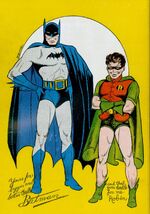
Batman and Robin
The introduction of Robin was another success and soon Batman was featured in his own comic book. Immediately after this, DC Comics, urged the writers to create enemies for the heroes and so, Joker and Catwoman debuted on Batman #1. Batman and Robin became the main characters in "Batman" and "Detective Comics" and also started appearing on the anthology title World's Finest Comics.
As Batman grew larger in popularity, the workload that Bob Kane and Bill Finger had to maintain was too much for them and soon, other artists and writers became part of the Batman and Detective Comics titles. Some of them included artists such as George Roussos, their early collaborator, Jerry Robinson, Jack and Ray Burnley, Lew Sayre Schwartz, Paul Cooper and most importantly, Dick Sprang, who defined the way Batman looked in the Golden Age. All of them worked as ghost artists for Bob Kane, who was still the only creator credited in the Batman comics. Various writers were also involved in the creation of the comics including Gardner Fox, Don Cameron, Joseph Greene, Edmond Hamilton, but Bill Finger remained the main writer of the Batman books.
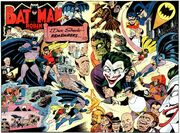
Batman and his characters by Dick Sprang
However, the introduction of Robin forced the writers to change Batman from his original concept. He could no longer carry weapons, much less kill enemies intentionally. For this reason, Batman stopped being a dark menacing figure who stalked the streets, hunting down criminals, but instead, he became a "father figure", always looking out for his young protege and capturing criminals in the least harmful way possible. It was an editorial edict that Batman would never kill, with any weapon of any kind.[1] It is for this reason that he stopped being a vigilante who worked outside of the law and became a deputized member of the Gotham City Police Department in Batman #7.
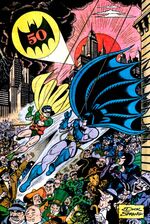
The Golden Days
This decision, helped DC when it came to Batman's enemies. In the early days, the criminals would die very easily and Batman would never confront a criminal more than a couple of times. With this new direction, the enemies were left alive and thus, they could return to haunt Batman. It is like this that the ever expanding list of enemies of Batman started to grow. In the Golden Age, several villains were introduced, some of them include Clayface, Hugo Strange, Penguin, Two-Face and Scarecrow, who became notorious characters in later years. There were also minor villains that were not featured during the Golden Age, but would appear on later years. They were the Cavalier, Deadshot, Killer Moth, Firefly, Mad Hatter and the Riddler.
Batman's supporting cast was also increased. Batman became friends with James Gordon, the Police Commissioner of Gotham City and he was soon joined by Alfred Pennyworth, who became Batman and Robin's trusted butler and aid in many cases. As Bruce Wayne, he would also have romantic interests such as Julie Madison, Linda Page, who disappeared shortly after. Perhaps the most notorious of the women in the Golden Age of Batman is Vicki Vale, who is still a relatively important character in modern times. Batman had also a flirtatious relation with his enemy, Catwoman.

The Golden Age
Over the years, the Batman's arsenal to fight crime was expanded and various elements were introduced. The first elements were the gadgets such as the Batarang and Batrope. Then came the vehicles, starting with the Batgyro and going to the Batplane, Batmobile, Batboat, Bat-Sub and even the Batcycle. The Batcave and the Bat-Signal where some of the latest additions to the ever-growing arsenal of Bat elements.
Batman had started as a serious manhunter, but in less than two years, he became a family law enforcer and remained the same for an entire decade. The stories featured in the Batman comics were also similar, to the point where they became repetitive in the late 1940s. By the end of the decade, the use of the well known villains like Penguin and the Joker, became more scarce as writers would rather have Batman and Robin confront regular criminals.
In 1950, the Golden Age ended, and the Batman comic books had a different concept from the very first books. By that time, the stories about the masked heroes fighting everyday criminals had oversaturated the market and most of the super-hero comic books were cancelled. Only Batman, Superman and Wonder Woman remained in constant publication. However, the only way to sell their comics, was by changing the concept of super-hero comics into something different, which in the end affected Batman more than the others. Superman and Wonder Woman were characters based on science-fiction elements, and thus, in the new upcoming age, their books expanded upon those concepts without seriously damaging their image. Unfortunately, Batman was never closely related to sci-fi. Some of the Batman comics from the Golden Age featured a very rare and occasional fantasy or sci-fi story, but with the end of the Golden Age, this elements were forced on the Batman comics, creating all sorts of scenarios, characters and situations never seen before in the books; which was not a good thing.
Silver Age
At the start of 1950, the Golden Age of comics had ended, but the next era of comic book publication would not start until 1956. During these 5 years of intermission, the Batman comics underwent a transformation process. The demand for super-hero comics was low and DC started publishing Western, Romance, Space and Mystery comics. These were the genres with the most popular demand and in order to follow the market trend of the time period, the Batman comics started featuring elements from said genres.
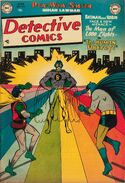
Firefly's debut in Detective Comics 184 (1952)
As a result, Batman was no longer a crime-fighter who would usually stand against criminals, but instead, he became a public figure, often regarded as a law enforcer. This trend was short lived, as elements from the upcoming Silver Age were starting to become more notorious. Batman was occasionally confronted by evil scientist with powerful machines or criminal geniuses who would try to reveal Batman's secret identity. In this time, few new characters were introduced and all of them were created as costumed criminals with a certain gimmick. Clear examples of these are the Human Magnet, Firefly and Killer Moth.
In 1954 the author and psychiatrist Fredric Wertham published a book about juvenile delinquency and the harmful effects of comic books in the younger generations. The book was called Seduction of the Innocent and it condemned the comic book industry for promoting evils of society such as violence, sex, drug use, and murder. Werham's main focus were the horror, mystery and superhero genre. The book had such a cultural impact, that society started a campaign against comic books and the "evil" it was supposedly conveyed on the magazines. For this reason, the comic book industry was forced to create an organization that would self-regulate the content of the comic books published in the US. By the end of 1954, the Comics Code Authority was formed and DC Comics became part of the self-regulatory movement.
The Batman comic books were not exempt from following the Code's norms, since some elements of the books were attacked by Wertham and his book. The psychiatrist made conjectures and theorized that Batman and Robin were the perfect image of a gay couple, and because of his success on other claims, this one was taken slightly seriously by the creative team in charge of the Batman comics.
Some of the writers from the Golden Age remained throughout the 50's, including Edmond Hamilton and Bill Finger, who were the most active writers in the Batman comics. Several of the artist who contributed to the books in the Golden Age remained until the mid-50's, when they eventually moved away from the books. Bob Kane was still involved in the creation of the art and he was still given credit as the sole creator of all the Batman comics published. This however, is false, as Bob kane had arranged a deal with his long-standing ghost artist, Sheldon Moldoff. It was Moldoff, who was the main artist in the Batman books for almost an entire decade, starting in the mid-50's. The inkers who worked alongside Moldoff were Charles Paris and Stan Kaye. Paris and Kaye also worked with Curt Swan on World's Finest Comics, where Batman and Robin started appearing on stories alongside DC' most iconic character, Superman starting with World's Finest #71

Batman's Wedding from Batman #122 (1959)
The Silver Age officially started in 1956 after the publication of Showcase #4, featuring a redesigned version of the Golden Age character, Flash. Partly to counteract Wertham's claims about Batman and Robin's homoexuality, editors Whitney Ellsworth and Jack Schiff started a movement and introduced new female characters to the Batman comics. Batwoman was first introduced in 1956, giving Batman a romantic interest as well as a partner for his various adventures. However, the movement didn't stop there and soon, many other characters were introduced in the Batman comics, as part of the trend started by the Silver Age. Batman and Robin were soon joined by Ace the Bat-Hound, Bat-Mite and Bat-Girl. The latter was used as a romantic partner for Robin and the whole cast of characters were placed on several strange adventures, but despite this explosion of new characters, there were very few new villains introduced. The most notable villain introduced in this time period was Mister Freeze, who made his debut in 1959.

The Batman Creature from Batman #162 (1964)
In the late 1950s, the Batman comics started featuring newer elements, proper from the decade and soon, Batman started going on space adventures, fighting aliens, robots and mythological creatures, travelling in time to meet his ancestors and descendants and using weapons based on science-fiction such as the Batman Robot and the Flying Batcave. A new kind of "Imaginary Stories" became notorious and they would often depict an unlike future for Batman, in which he married Batwoman and had a son, who would become the second Robin along with the second Batman, Dick Grayson. This elements and stories became a fixture by the end of the decade.
During the first couple of years of the 1960s, the Batman books featured some of the most bizarre adventures ever recorded in the history of the character. Batman was often placed in extreme situations in which he was transformed into a giant, or some kind of creature or reduced to the size of a baby. He would also gain superpowers, just to lose them in the same story. In these years, the only new villains created were Catman, a male version of Catwoman and Clayface, who was a different version from the original Golden Age villain.
This entire direction in the books was causing a drop in the selling numbers and DC considered cancelling the Batman comics altogether. However, being one of their most iconic characters and once their second most profitable intellectual property, DC decided to try a different approach on the books in order to revitalize the character. For this purpose, a simple change was made. Jack Schiff, who was the editor of the Batman comics since the mid-50's, was replaced with Julius Schwartz, the editor responsible for bringing back the Golden Age heroes Flash and Green Lantern and modernize them for the new generations. Schwartz was the man responsible for starting the Silver Age and DC assigned him to change Batman with a complete overhaul.
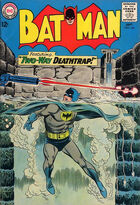
Batman's New Look from Batman #166 (1964)
Julius Schwartz's first action was to eliminate all the silly elements from the Batman comics including Batwoman, Bat-Mite, Ace the Bat-Hound and Bat-Girl, leaving Batman and Robin as the main characters of the books. Schwartz also wanted to have a different approach to the stories and make them more detective oriented. For this reason, he hired his long-time collaborators John Broome and Gardner Fox, who created some fine detective stories, much proper for Batman. Julius also wanted to redesign Batman's look, which had been the same for almost 25 years. He hired Carmine Infantino and Joe Giella and he promoted the change to the "New Look", in which Batman was no longer a stiff figure and the Bat-symbol on Batman's chest was surrounded with a yellow oval.
The "New Look" was introduced in Detective Comics #327 (1964) and marked the beginning of various changes in Batman, such as the death of Alfred, the introduction of Aunt Harriet and new villains like the Outsider and the Getaway Genius. Bob Kane was sill hired and remained credited as the main artist, although it was still Moldoff who adapted Kane's style and blended it with Infantino's new design. As a result of all this changes, the Batman comics gained a new popularity, one that allowed the creation of a live action TV Series on the ABC Network.
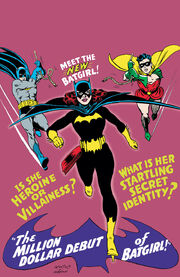
The New Batgirl - Detective Comics #359 (1967)
The Batman TV Show was a massive success, and the Batman comics reached the highest selling peak in history, being the number one sold comic in the industry for two consecutive years in 1966 and 1967.[2] These were the years in which the TV show was still on air, and as a result of the massive success, the comics were forced to change their new style and adapt the "camp" style used in the TV show. For this reason, Batman and Robin once again became public figures who would often pun while fighting criminals. Alfred was brought back due to the high demand of fans for the return of the character, who was present in the TV show. Many villains featured in the show also returned to the comics such as the Joker, Catwoman, Penguin and the Riddler. The creative team behind Batman was requested to create more villains and enemies for future use in the TV show and as a result, a large array of characters was introduced. Some of them include the villains Spellbinder, Blockbuster (who was a mock version of Marvel's Hulk), Poison Ivy, the Cluemaster, the Eraser and many more that became second rate villains. The most important introduction to the comics was the new female figure, Batgirl, who was in fact adapted to the TV Show.
Unfortunately, the TV Show was cancelled early in 1968 due to low ratings and the popularity of Batman waned. The Batman comics also dropped in sales and the only loyal fans of the character who endured the long "camp" period were extremely dissatisfied with the new approach for Batman. The damage created by the TV Show was noticeable and the fans demanded a change. In 1968 and 1969, Julius Schwartz tried to change the direction of Batman once again and hired Frank Robbins to create new scripts for Batman. Bob Kane was officially removed from the Batman comics in 1968 and Carmine Infantino was promoted to Editorial Director, the same year. Without artist for the Batman comics, Schwartz hired Bob Brown and Irv Novick as the main Batman artists. The team Robbins-Brown was assigned to Detective Comics while Robbins and Novick worked in Batman.
However, Frank Robbins' style was still reminiscent of the camp days, to some degree. Bob Brown's art was also too similar to the camp era and despite Novick's great art improvement, the imagery did not match the light tone of the stories. The change was not drastic and the people wanted the "real Batman" back.
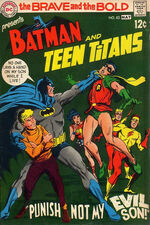
The Brave and the Bold #83
Cover by Neal Adams
Coincidentally, in 1967, during the top moments of popularity of the TV Show, Batman was used as a marketing tool and he was featured on almost every DC comic book. From Justice League of America to Adventures of Jerry Lewis. It was then that Batman took over the title The Brave and the Bold and became the main character, who was teamed up with several other heroes from the DC Universe. During 1967 and early 1968, the scripts of this comic followed the camp style and the art by Ross Andru was similar to that of the show. However, when the show ended, the stories penned by Bob Haney became much more serious and the art style was changed. Neal Adams, a new and upcoming artist, was hired to work in The Brave and the Bold and he created what the fans deemed as the definitive and real version of Batman. The B&B version of Batman was different from the one featured in Batman and Detective Comics, because Adams depicted the character with his own style. While Batman was amusing in his own comics, Adams presented a serious, smart and cunning version of the Dark Knight. Batman's suit was also important, since he would wear a very short cape and short ears in his own books, while Adams' version featured a very large cape and long ears, which created a more frightening figure.
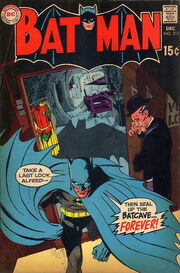
Batman #217 (1969)
End of the Silver Age
The fans noticed the difference between the "funny" Batman from his own comic books and Neal Adam's version from The Brave and the Bold. Julius Schwartz became aware of the success that Adam's version of Batman had with the fans and he instructed his artists, Brown and Novick, to follow Adam's style. This, however, didn't prove to be a good solution and after trying many different things, Schwartz decided that it was time to give Batman a complete change. In October-December of 1969, the creative team allowed Dick Grayson to finally graduate from high school and made him leave Wayne Manor to attend college. Robin had been divided between his sidekick role in the Batman comics and his leader role in the Teen Titans book. After 30 years of history together, Batman and Robin were finally separated and Batman became the lone figure of the night once again. For this reason, Bruce Wayne decided to leave Wayne Manor and moved to his Penthouse Apartment in the middle of Gotham City. Batman became a multi-dimensional character as he started working as businessman at the Wayne Foundation by day and as the Dark Detective at night.
This was promoted as "the big change", and it served as the ending of the silver age.
Bronze Age
The 1970s

Detective Comics #395 starts the Bronze Age
The year 1970 marked the beginning of the Bronze Age, with Batman taking the lead of the change. Having Batman return to his original status quo of being a loner crime-fighter, was not enough for the fans and neither for editor Julius Schwartz, who wanted to bring back everything that made Batman great in the Golden Age. For this purpose, Schwartz assigned one of DC's top writers, Dennis O'Neil to write some of the upcoming Batman stories and he also managed to get Neal Adams to illustrate O'Neil's scripts. Dennis O'Neil was aware of Julius Schwartz need to return Batman to his roots and so he read some of the early Golden Age Batman stories to get the general idea. In January of 1970, "The Secret of the Waiting Graves" was published in Detective Comics #395 and it became an instant landmark in the history of Batman and the comic book industry. O'Neil's script managed to return Batman to his former glory as a dark avenger of justice, while Adams' illustrations became the norm for the Caped Crusader.
O'Neil's success influenced the then Batman writer Frank Robbins and both of them started sharing the writing duties of the Batman comics. Neal Adams would contribute occasionally, but he was always busy with other assignments. For this reason, Irv Novick and Dick Giordano became the main artists of the Batman books and even though, Bob Brown tried to emulate Adams' style, he was not able to represent the new Batman and was removed from the books within the first year.
Following the trend started by O'Neil, the Batman comics started featuring mystery, horror and supernatural type of stories. The stories also became more focused in evoking awe by presenting atmospheric scenarios rather than complex criminal plots and the formula worked fine, as it brought back elements from the early Batman stories and modernized them. However, the readers noticed the lack of "challenge" in the Batman comics and it was due to the lack of villains, who were almost vetoed since the end of the Silver Age, because they were all too reminiscent of the camp days from the 60's TV show and they were all deemed as unsuitable for the new Batman and the new environment of his stories.

Ra's al Ghul; introduced in Batman #232
Instead, Schwartz assigned the writers to come up with new villains that would fit the mood of the new Batman stories, and Frank Robbins created Man-Bat, who first appeared in Detective Comics #400 with illustrations by Neal Adams. Man-Bat was featured prominently afterwards, almost always under the Robbins-Adams team, until eventually Adams was not available and Robbins illustrated his own stories, which received mixed reviews for his unconventional style. Robbins used heavy shadows and inks compared to the clean and more refined style from Neal Adams and this was the cause for some criticism about the quality of the books. Meanwhile, Dennis O'Neil had been working with Adams in order to create the ultimate adversary for the Batman and they had help from Julius Schwartz when he suggested the name Ra's al Ghul. This new and formidable adversary first appeared in Batman #232. O'Neil had already created the League of Assassins and he used these previous stories to connect Batman to the bigger storyline featuring Ra's al Ghul and his daughter, Talia al Ghul, who started a conflictive romantic relationship with the Dark Knight.
Besides these two new villains, there were a couple of less interesting characters such as the Ten-Eyed Man and The Spook who never gained much attention. There were also a couple of new supporting characters introduced like Jason Bard and Shotgun Smith. However, after two years of repeating the formula and villains, the creative team of Detective Comics changed their style and returned to the criminal plots of old with a focus on clues and information for the audience to "crack the case" along with Batman.
In the first two years of the Bronze Age, Robin's stories continued the formula of a crime-fighting college student, but he would have his occasional appearance along with Batman. Meanwhile, the Batgirl stories decreased in popularity and soon, her back-up features in Detective Comics were removed.
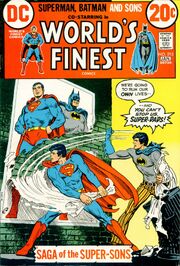
The Saga of the Super-Sons
The first two years of the Bronze Age were also relevant for Batman, as he stopped being the main character on World's Finest Comics after Julius Schwartz took the editorial command of that title. Batman had been a main character in the title since 1941 and 32 years later, he was removed. Meanwhile, Batman grew stronger on his other team-up title, The Brave and the Bold, where the stories were still penned by Bob Haney, but the artist was changed from Neal Adams to one of the most prominent Batman artists of history; Jim Aparo. In 1973, Murray Boltinoff and his team were placed in charge of World's Finest Comics after Julius Schwartz was removed from that title and they returned to the old formula of teaming-up Batman and Superman. Haney was placed in charge of the writing chores and Dick Dillin was assigned as the main artist. Using this new outlet, Haney experimented with a Silver Age idea, modernized for the Bronze Age: the Super-Sons, which featured the would-be teenage sons of Batman and Superman working to become heroes on their own right and growing away from their parents' shadows. The series continued to appear sporadically in World's Finest along with the regular team-up stories, but they eventually faded away.
By the end of 1973, Julius Schwartz moved away from Detective Comics, but remained in Batman. The editorial and writing assignments of Detective were passed on to Archie Goodwin, who worked with several artists including Jim Aparo, Sal Amendola and Walt Simonson. Goodwin's first change was the return of the original logo for Detective and he started working with the artists using the so called "Marvel Method". It was during his run as editor and writer of Detective Comics that DC decided to increase the page number of their comics and raise the price in an effort to improve the low sales. However, the amount of work was far too taxing and Goodwin resigned a year after he started, returning the editorial seat to Schwartz while he moved on to work for Marvel Comics.
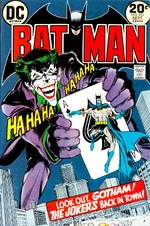
The Return of the Joker
During Goodwin's year at Detective, Schwartz decided to experiment in the Batman comic with the classic villains that the audience demanded. This change of perspective might have been started thanks to the popularity of the Super Friends TV Show, which featured classic Batman enemies. In 1973, Julius Schwartz published the long-awaited return of Batman's arch-enemy, The Joker, after almost four years of absence. Dennis O'Neal and Neal Adams were responsible for creating "The Joker's Five Way Revenge" in Batman #251. The story became an instant success, as O'Neil gave Joker the same treatment as Batman and he returned the character to his dark and twisted origins; creating a much more realistic and gruesome version of the character, much different from the clown it had become. The success of this story also allowed the creative team in Batman to bring back the rest of the Rogues Gallery. The first couple of enemies that were reintroduced were Catwoman and the Penguin, but their stories weren't as successful as the Joker's story. However, when Two-Face was brought back in Batman #258, Dennis O'Neil used a new idea that changed Batman for good. He proposed that criminals like the Joker and Two-Face were all incarcerated in a special facility for the criminally insane, which he called Arkham Hospital, and this would later evolve to Arkham Asylum. This development helped establish the new status quo between Batman and his large array of enemies.
When Julius Schwartz returned to Detective in 1975, he assigned Jim Aparo as his main artist and Len Wein as the main writer in order to create a new saga in the title. Wein had previously worked on a couple of Batman comics, which were critically acclaimed and he was notable for his work in the eerie title Swamp Thing. The saga created by Len Wein in Detective featured the brief return of Ra's al Ghul and the League of Assassin. Afterwards, Schwartz found a new artist for Batman and Detective Comics.

David Reed's Crowning Achievement
Ernie Chan penciled many of the Batman comics in 1975 and 1976. After Ernie Chan's departure in 1977, many artists filled in the illustration chores of Batman including Romeo Tanghal, John Calnan, Mike Grell, Sal Amendola and Michael Golden. After Len Wein ended his tenure in Detective, Schwartz brought in new writers such as Rich Buckler and Elliot S. Maggin. Julie Schwartz then hired one of his long-time friends and science-fiction writer, David Vern Reed, who was assigned as the main writer in Batman. For almost 4 years until 1978, Reed contributed several stories for Batman, some of which were the first large storylines in the comic series, although they were simply one big story told in different chapters. Reed had previously written one story for Batman in the Golden Age, when he created the character Deadshot. His writing style was complex, organized and methodical, which made for really interesting stories. However, he didn't use many of the elements of the Batman mythos and never changed or introduced any important events or characters, which is why his run is not considered relevant and often forgotten in the grand scheme of the Batman history.
The success of the Batman comics resulted in the creation of a couple of spin-off series. Due to the previous success with the Joker character, Julius Schwartz was assigned as editor of the first comic to feature a villain as the main character. "Joker" debuted in May of 1975 and it was quite successful. Most of the stories were written by Denny O'Neil, Elliot S. Maggin and illustrated by Irv Novick. Unfortunately, due to the restrictions caused by the Comics Code Authority, the series ran for only nine issues before it was cancelled.
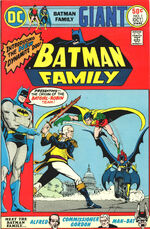
Introducing
"Batman Family"
Meanwhile, the back-up features in "Batman" and "Detective" featuring Robin and Batgirl were in high demand. As a result, in 1975, Julius Schwartz and his editorial office launched a new title called Batman Family and not long after this, Gerry Conway and Steve Ditko from the Marvel and "Creeper" fame started a new series with Man-Bat as the main character. Unfortunately, Man-Bat was cancelled after two issues and this stories were first moved to Detective Comics before they were included in Batman Family. The BF series was much more successful than the main Batman titles and it was eventually changed in format to become an 80-page dollar comic, similar to World's Finest Comics. With this change, Batman Family was assigned to Al Milgrom as the new editor. The series featured Robin and Batgirl as the main protagonists and then the cast was expanded to include Man-Bat, Commissioner Gordon and even Huntress. Bob Rozakis, who was in charge of scripting the stories also included several of the characters from the Silver Age like Batwoman, Bat-Girl and Bat-Mite in new stories, but their revival was not considered a good improvement.
Several new writers and artists contributed many of the Batman titles including Bob Rozakis as assistant editor and writer, Michael Uslan as writer and Dick Giordano as inker and occasional penciler in Detective Comics. Around this time, new lesser villains were introduced in "Detective" like Captain Stingaree by Rozakis and Uslan, and Black Spider by Gerry Conway. Despite this rotation of artists and writers, the sales of Detective dropped and the series was forced to turn into a bi-monthly schedule.
Despite the change of schedule, Detective Comics saw one of the most important creative teams in the history of the series and arguably, one of the best in the history of comics. The storyline which has become known as Batman: Strange Apparitions started in Detective Comics #469 with Steve Englehart as the writer, with illustrations by Walt Simonson and Al Milgrom. During the first issue, they introduced new villains such as Doctor Phosphorus and Rupert Thorne. On later issues, Simonson and Milgrom were replaced by Marshall Rogers and Terry Austin. Their art combined with Englehart's scripts, made of this storyline one of the most iconic in the history of Batman.

The Bronze Age Magnum Opus
They introduced a new romantic interest for Bruce Wayne called Silver St. Cloud, who fans regard as the best partner for Batman. Englehart and Rogers also re-introduced forgotten villains from the Golden Age including Hugo Strange and Deadshot. Marshall and Austin's illustrations returned Batman to the enigmatic figure of the night of the Golden Age. After the revival of forgotten heroes, they created the iconic "Laughing Fish" storyline, where Joker was portrayed in the same way as his golden age counterpart with modern elements for the younger audiences. By the end of the storyline, another villain was introduced as Clayface III; a modern take on the previous villains by the same name. This storyline also marks the first time when previous creators on the Batman history start to become referenced inside comics as buildings and landmarks in Gotham City. However and despite all the critical acclaim from fans and industry professionals alike, the sales of Detective Comics decreased, forcing the comic to change the schedule yet again to 8-times a year.
By the end of the 70s, the audience demanded a change in Robin's persona. As the Teen Wonder was prominently featured in Batman Family, both alone and with Batgirl, it was time for a change. The audience wanted a new name and costume for the former sidekick, but the writers wouldn't risk losing the merchandising image of Robin and instead they developed the character by giving him romantic interests, which included his partner, Batgirl. This would mark the beginning of the one of the longest love relationship in DC Comics.
By 1978, ten years had passed since Bob Kane stopped working for Batman and he made effective his contract where all Batman stories were to be credited to him. Like this, all Batman comics started featuring the "Created by Bob Kane" tag in the credits box along with the names of the creative team.
Batman's additional comics like World's Finest and The Brave and the Bold were still created by Bob Haney and a whole team of artists and editors including Dennis O'Neil, Jack C. Harris, Kurt Schaffenberger, Tex Blaisdell and Michele Wolfman. Meanwhile, as Batman Family had increased the page number, more artists were required and new talents joined including colourists Adrienne Roy, Tatjana Wood and illustrator Jim Starlin.

Detective goes "Family"
By the end of 1978, Julius Schwartz officially ended his run as editor of the Batman comics, making his final bow with Batman #309. The books were subsequently assigned to Paul Levitz in 1979. This change was the first of many on the whole group of Batman books. First, Batman Family was merged with Detective Comics to improve the poor sales of the latter, resulting in Detective Comics becoming an 80-page dolar book starting with Detective Comics #481 and soon, it returned to its monthly schedule. The book retained most of its the creative teams from Batman Family and Detective Comics, but several of the stories changed its direction, eliminating the Silver Age characters. Meanwhile, David V. Reed moved away from Batman and after a short stint by Gerry Conway, Len Wein returned to DC after his work in Marvel. He was assigned as the main writer on Batman and the illustrating chores returned to Irv Novick, the artist who started the Bronze Age working on Batman. Wein and Novick's run in Batman is considered the first step towards the end of the Bronze Age, as not only it introduced new characters as Lucius Fox and Firebug, but he also introduced many subplots and the storylines, which helped establish a sense of continuity on the Batman comics. For instance, while Batman was struggling against several Golden and Silver Age villains that were revamped, Lucius Fox would face problems at Wayne Enterprises and Bruce Wayne would start a serious relationship with a reformed Selina Kyle.
The last year of the decade is notable for the work of Dennis O'Neil, Don Newton and José Luis García-López. A new villain called Maxie Zeus was introduced in Detective Comics and a new storyline featuring the League of Assassins and Ra's al Ghul became the main focus, all done by O'Neil. One of the most notable events of 1979 was the storyline from Adventure Comics #462, in which the Golden Age version of Batman died after retirement, marking a groundbreaking development for the character among other changes to the Batman mythos, but none of those affected the mainstream continuity of the Dark Knight. Finally, at the end of the decade, long-time writer of the team-up title The Brave and the Bold, Bob Haney, was removed from scripting duties. The book had received several complaints about the lack of continuity and depth to the stories and it was clear on every story written by Haney. Bob Haney was the last writer who had started his work on Batman during the Silver Age and was still active a decade later. For this reason, Paul Levitz started a rotating system of new writers on The Brave and the Bold, but Jim Aparo, the resident artist, continued his work after Haney's departure.
The Early 1980s
At the start of the new decade, the trend started by the end of the 70s continued, with Levitz still as the editor of all Batman comics, except for World's Finest Comics, which was under the editorial hand of Jack C. Harris. The changes in the Batman history were linked to the changes in the DC Universe and their publication history. However, there are some few important developments that are worth mentioning prior to the big change in 1986.
In 1980, the sales of Detective Comics improved enough that the title was returned to its monthly schedule permanently and a few months later, the 80-page dollar comic format was dropped in favor of the regular 36-page comics, which featured a 16-page main story on Batman and a 8-page back-up story featuring Batgirl. This year also saw the end of Dennis O'Neil's contributions as a writer after his departure to become an editor for Marvel.

The Untold Legend of Batman
After the success of the mini-series titled World of Krypton in 1979, DC published the notorious Untold Legend of the Batman limited series, written by Len Wein and illustrated by John Byrne and Jim Aparo. The series was the first Batman publication outside of the main line of books and it was a re-telling of the origins of Batman and some of the best known supporting cast and long-time enemies. The success of the series allowed Len Wein to gain notoriety on the medium and this newfound notoriety, helped Wein a few years later.
With Wein busy working on the previous mentioned mini-series, Paul Levitz hired Marv Wolfman, Cary Burkett and Mike W. Barr to write stories for the Batman comic. Levitz also hired Gerry Conway and Michael Fleisher to write stories in Detective Comics. The Batman comic started featuring Catwoman on solo stories as a reformed villain and this helped her become a more interesting character than she ever was as part of the Batman's rogues gallery. Starting in Batman #332, Marv Wolfman began an epic 4-part storyline known as "The Lazarus Affair", in which he used Ra's al Ghul as the main villain. The story was similar to previous stories featuring Al Ghul, but what made it interesting was that Wolfman created a growing tension between Batman and Robin, as they no longer could work as partners. Once Wolfman ended his storyline, he moved away from the Batman comic, but he continued to develop the friction between Robin and Batman on his title, New Teen Titans.
By 1981, Paul Levitz ended his run as editor, choosing to remain active in the production area of DC Comics and Dick Giordano became the new Batman editor. Giordano's first and most important association was with writer Gerry Conway, who became the permanent writer on Batman and Detective Comics. Having Conway writing stories for the two main Batman comics allowed Giordano to experiment with an idea that was only used once during the years of Schwartz as editor. Starting in 1981, Batman and Detective Comics started featuring continued stories that started in one comic and ended in the other. This "crossover trend" allowed the creative team of Batman to further increase the continuity of the books. On the artistic chores, Giordano assigned Gene Colan as the main artist in Detective Comics and Batman after Irv Novick's run. Colan's style was filled with heavy shadows and thick outlines, which some fans regarded as a much needed "darkness" in the Batman comics. As all this happened, Batgirl was forgotten.
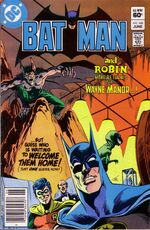
Back to Basics
The team of Giordano, Conway and Colan was not precisely what could be called "original", as most of their ideas came from previously developed stories. Taking a cue from the masterpiece of the 70s by Steve Englehart and Marshall Rogers on the "Strange Apparitions" storyline, Conway decided to bring back a multitude of forgotten characters from the Batman mythos. Like this, Conway re-introduced Vicki Vale, the photographer/reporter who was prominently featured in the Golden and Silver Ages as a romantic interest of Batman/Bruce Wayne. As for the villains, Conway re-introduced the original Golden Age Mad Hatter, who was different from the character developed in the Silver Age; the Monk, who was a twisted version of the original Mad Monk; Colonel Blimp, who was based upon an early Batman villain called Carl Kruger and a few others, who in the same vein, were re-envisioned versions of past characters. This trend continued for the best part of 1981 and 1982. However, the most important development brought by this creative team was the official return of Batman and Robin to Wayne Manor and the original Batcave after 12 years since Schwartz changed the status quo. This new development helped Batman become more focused on his quest as the duties of Wayne Enterprises were left to Lucius Fox. After this such development, Dick Giordano was promoted to Executive Editor and the editorial office of Batman was passed on to Len Wein, who had proved his worth when dealing with Batman.
Wein continued working with Conway as the main writer, but he assigned new artist Don Newton as the main Batman artist while Gene Colan remained in Detective Comics. In one of the first stories of the new creative team, Batman was transformed into a vampire, something that had never been done and an idea that was explored on later years. As editor, Wein became the man of the transition in the Batman comics. He reintroduced the "Batman Annual", which now featured new content instead of reprints of old stories. There was also the cancellation of the long-running Batman team-up book "The Brave and the Bold" with issue #200.
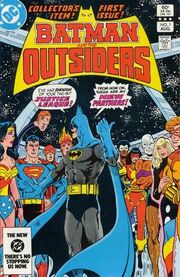
Batman and the Outsiders
In 1983 and with the rise in popularity on team books such as the New Teen Titans and the X-Men from Marvel, DC wanted a new team book and Wein collaborated with Mike W. Barr and Jim Aparo, who had worked in The Brave and the Bold and they created the title called Batman and the Outsiders. This was a test book in which Batman was used as a catalyst to introduce a new group of characters such as Halo, Katana and Geo-Force with old heroes such as Metamorpho and Black Lightning. The experiment was a success as the characters and the team gained enough popularity to earn their own title, Outsiders. However, Batman's inclusion in the team was ill-advised as he was never meant to remain a permanent member of the team. For this reason, Mike W. Barr's characterization of the Dark Knight was severe and different from the other publications. For instance, Batman resigned the Justice League in an uncharacteristic fit of anger. He also became the automatic leader of the Outsiders, using them for his own purposes and as means to a goal. This meant that the Batman from this series was a manipulative sociopath with little to no empathy for others, who relished the thought of violence against criminals and even allowed members of the team like Katana, to murder crooks in his presence. This psychopathic depiction of Batman ended with issue #32 of "Batman and the Outsiders", when he left the group and the comic was renamed as "Adventures of the Outsiders".
Meanwhile, on the main Batman comics, Gerry Conway continued his trend of copying the Englehart/Rogers masterpiece and decided to develop an ending to the Hugo Strange/Rupert Thorne storyline. After this, Conway introduced Julia Pennyworth as the daughter of Alfred and set in motion his idea of creating a new Robin for Batman and thus, he introduced Jason Todd, whose background was far too similar to that of Dick Grayson to make it believable. In order to have Jason being taken in by Bruce Wayne, Conway created the nefarious villain called Killer Croc, whose only purpose was to kill Jason's parents before he was utterly forgotten for the few upcoming years. Unfortunately, Conway just set the stage for Jason to become the new Robin, but his contract as Batman writer expired and it was up to the next Batman writer to develop the introduction of Jason Todd as the new Robin.
Fresh from his work at Marvel Comics, where he had created the character Moon Knight, Doug Moench became the new Batman writer by the mid-1983 with Colan and Newton as the artists. Moench's originality was refreshing and developed the storyline in which Jason Todd became Robin simultaneously with Marv Wolfman's storyline in New Teen Titans where Dick Grayson abandoned the Robin identity and became Nightwing. Moench also brought back a character who was first mentioned during Archie Goodwin's run on Detective Comics.

Night Lovers
Harvey Bullock was an offbeat character, who was first portrayed as a mild antagonist for Commissioner Gordon, but Moench developed the character further into the beloved figure that he is today. Doug Moench's most notable effort was the introduction of the character Nocturna, who was at first an antagonist to Batman along with her partner, the Night-Slayer, but later became a romantic interest of the Dark Knight, taking the place of Vicki Vale and the previously introduced Julia Pennyworth. First appearing in Batman #368, Nocturna gained notoriety over the years as she first tried to gain legal adoption of Jason Todd and later became romantically involved with Batman, making it one of the most strange and alluring romances in the history of the character. However, Moench decided that his character should never be used again and he elaborated a master storyline in which Nocturna was presumed dead and never seen again. To reduce the chance of having other writers use Nocturna, Moench also made Batman resume his relationship with the longest-running love interest: Catwoman.
Moench's run lasted from 1983 until 1986, time in which the sales of Batman and Detective Comics significantly declined. There are many reasons why this could have happened and among them are the endless run of crossovers in which the stories between Batman and Detective Comics were always combined, making it impossible for casual readers to enjoy a single story. Another likely reason was the artstyle. Gene Colan and Don Newton had unusual art styles, different from what many comic book professionals were doing in those years. Their art was not fit for the monthly releases of the Batman comics and many readers dropped the books after Colan's and Newton's four years on Batman. Lastly, there was the introduction of Jason Todd, who many fans deemed as a "cheap Robin clone", for all his background and the reasons why he ultimately became Robin were not feasible and the fans of the original Robin also moved away from the Batman comics.
1986 is considered by many the ending of the Bronze Age of Comics and the start of the Modern Age. Many changes happened in the course of this year and Batman was not exempt from these changes. World's Finest Comics, the comic in which Batman was one of the main characters and which was expanded in 1983 to include full-length stories about Batman and Superman, was ultimately cancelled in January of 1986, as the modern characterization of both characters made it impossible to continue its publication. After Don Newton's untimely demise, a few artist contributed to the Batman comic including Rick Hoberg, but most importantly there was Tom Mandrake, who illustrated the last Moench saga between Batman-Nocturna. Moench and Mandrake also introduced the notable character Black Mask and the minor character known as Film Freak. The collaboration between editor Len Wein, writer Doug Moench and artist Gene Colan came to an end after the anniversary event called Crisis on Infinite Earths altered the history of all the characters of DC Comics, giving the company the chance to start anew with different creative teams on every department and change the background and flawed origins from every DC character.
Modern Age
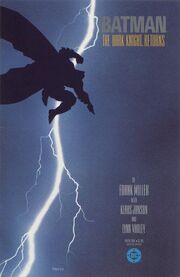
The Dark Knight Returns
All of the previous developments made little to no difference when it came to increasing the popularity of Batman as a dark and brooding character. That feat is credited to one of the most significant milestones in the history of the comic book industry. Frank Miller, best known for his revamping of the Daredevil character in Marvel, had worked for DC in small projects such as Ronin and he talked with executive editor Dick Giordano about a different version of Batman he wanted to do. After a few months of production, Frank Miller came up with Batman: The Dark Knight Returns, which told the story of a 50-year-old Bruce Wayne who had retired from his crime-fighting activities, but decided to return as the situation in Gotham grew out of control. The story was published in a "graphic novel" format, something that was never done before and it gained critical praise from fans and industry professionals alike. The success of the series was covered by the mainstream media and it is considered as the piece of work responsible for giving Batman his former glory back and indeed, it changed the way the character was perceived for generations to come.
However, besides Giordano and Miller, there was someone else involved in the creation of the Dark Knight Returns and that was editor Dennis O'Neil, who returned to DC after his stint at Marvel. Because of the success of the Dark Knight Returns, O'Neil was promptly assigned as editor of the main Batman books, replacing Len Wein and signaling the beginning of the Modern Age of Comics in the history of Batman.
The O'Neil Years
The first of many changes that O'Neil implemented in the Batman comics, was the end of the crossover continuity storylines between Batman and Detective Comics by the end of 1986. This marked a definitive departure from the previous publication era, as the creative teams of each title was separated with only O'Neil acting as the director. This decision was replicated across the company in an effort to move away from the convoluted continuity from the past into a new era of comic publication. Unfortunately, executive decisions prevented the series and creative teams from starting fresh from the very beginning.
After the success of Crisis on Infinite Earths, DC came up with a new crossover event called Legends and the Batman titles were also involved as tie-ins. Former Batman writer, Mike W. Barr was appointed as the writer in Detective Comics and newcomer Max Allan Collins became the writer in Batman. The initial issues of both titles were tame in terms of establishing new elements for the new continuity due to the Legends crossover, but things eventually changed when O'Neil assigned notorious writer Frank Miller to create a new origin for Batman.
Batman: Year One and Two
Main articles: Batman: Year One and Batman: Year Two
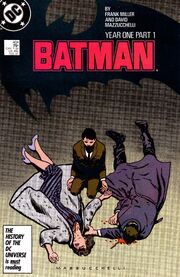
It all begins... again.
The new origin for the new Batman continuity was first published on the acclaimed storyline called Batman: Year One, written by Frank Miller, best known for his work on "The Dark Knight Returns" and artist Dave Mazzucchelli, who had previously collaborated with Miller on "Daredevil" for Marvel Comics. Under the editorial direction of Dennis O'Neil, this story became the quintessential Batman origin, which was based upon the original story by Bob Kane and Bill Finger and disregarding previous developments that contained continuity issues. Once again, Frank Miller's Batman had become a total success and the Batman title was reinstated one of DC's best comic books. After "Year One" was over, Allan Collins resumed his chores as writer in Batman and he revamped the origin of Jason Todd for the new continuity, extremely departing from his Pre-Crisis origin.
Following Miller's success, O'Neil promptly organized a sequel to "Year One". Batman: Year Two was published in Detective Comics and it was written by Mike W. Barr with illustrations by Alan Davis and Todd McFarlane, who would go on to become a prominent figure in the comic book industry. Unlike "Year One", "Year Two" was not a success and over the years it has been forgotten as part of the canon history of Batman, as well as much of Mike Barr's run in Detective Comics after the Crisis. The reason why this happens is because Mike Barr's characterization of Batman and his supporting characters are not in line with the portrayal of the characters in other publications. Barr's stories also contain several references to previous elements from the Batman history, which no longer fitted in the new continuity.

Son of the Demon
As the two previous storylines developed, editor Dick Giordano and Mike Barr also worked on a new graphic novel following the success of "The Dark Knight Returns". Published in the same "prestige format", Batman: Son of the Demon was released in 1987, but it didn't meet the same success as TDKR. Once again, Mike Barr's work on the character conflicted with the general continuity of the character and this story was disregarded and forgotten until it was picked up by other creative teams, several years later.
The general nuisance of Mike Barr's stories prompted a change by the end of 1987 and some of his last collaborations in Detective Comics were alongside upcoming Batman artist Norm Breyfogle. Mike Barr was soon replaced by British writers Alan Grant and John Wagner, starting in Detective Comics #583. The team of Wagner, Grant and Breyfogle had become a cult classic in the Batman publication history, as their run lasted for almost 4 years in which they created some of Batman's most notable adversaries like the Ventriloquist, the Ratcatcher and the Corrosive Man. 1988 was also the year when the "Detective Comics Annuals" started to being published alongside the "Batman Annuals". Meanwhile, the creative team behind Batman was also changed after Allan Collins' short stint. He was replaced in the scripting chores by veteran comic book creator, Jim Starlin and the stories were illustrated by legendary Batman artist, Jim Aparo, marking the start of very important changes.
Killing Joke & Death in the Family
Main articles: Batman: The Killing Joke and Batman: A Death in the Family
1988 is perhaps one of the most important years in the entire history of Batman. This year saw various developments that changed the character as a whole and drew mainstream media to comic books once again. As the decade came close to an end, the stories told in the comic book industry as a whole were darker and somber in tone compared to other times. This time is usually and unofficially called the "Dark Age of Comics" for publications such as Watchmen, V for Vendetta and the rise of Vertigo as an independent publisher for mature readers.

Killing Joke
The Batman comics were also influenced by this dark depiction of events and circumstances that generated little other than shock value. One of the notable writers of this period was Alan Moore, responsible for the two publications previously mentioned. Alan Moore was approached to create a Batman graphic novel. Moore worked with artist Brian Bolland and together they created what has become the ultimate Joker story in Batman: The Killing Joke. The publication was extremely successful and well received by the general public, despite the visual depiction of torture and gore. This story is notable not only for establishing an origin for one of comic books' best known characters, but also for crippling Barbara Gordon, who had been Batgirl.
The Killing Joke has been rumored to have been published as a story outside of mainstream continuity, but it has since been proved otherwise. The most notorious fact against this claim is the publication of Batgirl Special #1, in which Barbara Gordon officially retires from her Batgirl identity and it was published a few weeks prior to the Killing Joke. Similar to what "Batman: Year One" is for Batman, "Batman: The Killing Joke" has become the most relevant Joker story in any media.
Shortly afterwards and following the trend of creating graphic novels, Batman writer Jim Starlin was teamed up with notorious horror artist Bernie Wrightson and they came up with another "prestige format" publication titled Batman: The Cult. In this story, Gotham City is taken over by a mad cultist called Deacon Blackfire, who manages to subdue Batman and breaks the hero for the first time in history, figuratively. The story gained a little more success that "Batman: Son of the Demon", but it failed to reach the success of TDKR, despite the fact that it was written and illustrated in a very similar fashion to the Frank Miller's milestone.

The Killing of Robin
By the end of the year, O'Neil came with a strange idea in order to have the audience decide the future of one of his characters. Working alongside writer Jim Starlin and artist Jim Aparo, they came up with the storyline called Batman: A Death in the Family, in which Jason Todd, the second Robin, was ultimately killed. O'Neil set an automatic phone number that people could call and dial a number in order to have Jason killed or saved by the end of the storyline. Surprisingly, the final toll was close, but the final decision was to kill the Boy Wonder. Jason was killed by Joker, who once again, cripples the "Batman Family" in a gruesome manner. The death of Jason caused an upheaval in the Batman continuity and the media's reaction to the news was wildly exaggerated, which served enough to promote the Batman comics and the upcoming Batman film.
In 1989, DC Comics celebrated the 50th Anniversary of Batman and the first Batman feature film was released. It was directed by Tim Burton and featured the Joker as the antagonist, inspired by "The: Killing Joke" graphic novel. As to take advantage of the film's publicity, editor Dennis O'Neil hired the movie's screenwriter, Sam Hamm, and assigned him to create a lengthy story to celebrate Batman's anniversary. The story was called Batman: Blind Justice and it was published in Detective Comics with illustrations by Denys Cowan, a long-time collaborator of O'Neil on The Question comic book. "Blind Justice" was published in three issues, as to have the end of the story coincide with the release of the 600th issue of 'Detective Comics'. These issues also featured multiple pin-ups and written messages by notable artists, comic creators and celebrities who joined the celebration.
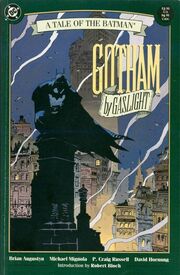
The "first Elseworld"
Another remarkable publication around the same time is Batman: Gotham by Gaslight, which was an 'alternate tale' featuring Batman. The story is set in the 18th century, as opposed to the modern setting of the regular publications. It was written by Brian Augustyn and illustrated by Mike Mignola. "Gotham by Gaslight" is a retelling of the "Jack the Ripper" mythos and it confronts Batman against one of the most enduring urban legends in history. Although it wasn't published under the Elseworlds label, "Gaslight" has been retroactively considered the first Elseworlds publication, as it ushered a new way to tell different kind of stories for DC Comics, using their most popular characters.
That same year, DC published a Catwoman mini-series. Written by Mindy Newell and illustrated by Joe Brozowski, this series established a new origin for Catwoman, based on the earlier work by Frank Miller in "Batman: Year One".
Despite all of the publications mentioned, the general public's attention remained on the Batman title after the "Death in the Family" stunt. People were not happy about the death of Robin and as a result, Jim Starlin was dismissed from his writing duties in the Batman title, ending his run in issue #430. The end of Starlin's run also marks a radical change in the Batman comics, as new writers and artists take the mythos in a different direction.
Year Three, A Lonely Place of Dying and Batman 1989
Main articles: Batman: Year Three and Batman: A Lonely Place of Dying
After Jim Starlin's run in Batman, there was a notable void in terms of storytelling. The lack of a Robin figure was evident and the aftermath to his death was not properly treated. Editor Dennis O'Neil knew exactly how to fix the problem, but the sudden end of Starlin's run left him understaffed. O'Neil required time to get a new writer for Batman, with whom he could change the direction of the comics. In the meantime, O'Neil hired writers Christopher Priest and John Byrne. Priest came up with 3 stand-alone stories that dealt with Jason Todd's death and John Byrne created a 3-part story called Many Deaths of the Batman. These stories were illustrated by legendary Bat-artist, Jim Aparo.

Batman Movie Comic
After 6 months, O'Neil was ready to introduce the new creative team that would change the direction of the Batman comics. They were writer Marv Wolfman and artist Pat Broderick. The first storyline they came up with was Batman: Year Three, in which they revisited the origin story of Dick Grayson as the original Robin. Although the origin story of the Boy Wonder was not heavily altered like Batman's origin was in "Year One", the story was actually a prelude to something bigger. Marv Wolfman was best known for taking Dick Grayson out of his Robin persona and creating his identity as Nightwing. Following that train of thought, Wolfman came up with an idea to introduce a new Robin to the Batman mythos. A character that would prove much more likable than the previous Robin. Coincidentally, the Batman movie of 1989 was released around the same time as this storyline was published and DC released a Comic Book Adaptation of the film, written by Dennis O'Neil and illustrated by Jerry Ordway.
Immediately after "Year Three", Marv Wolfman started working in the storyline that would introduce the new Robin. Artist Jim Aparo returned to illustrate Batman, but this story required outside help. Marv Wolfman was also writing the New Titans comic book and he convinced his editors to let him introduce the new Robin in a crossover between the Batman and New Titans series. The storyline was called Batman: A Lonely Place of Dying and it was published from issues #440 to #442 of Batman, as well as issues #60 and #61 of New Titans, illustrated by George Pérez.

"A Lonely Place" introduced the character of Tim Drake to the Batman mythos, but it didn't force him into the role of Robin right away. Instead, the storyline worked as a presentation of the new, "possible" Robin and built his character, making him worthy of the title. The storyline gained a massive following, not only due to how well crafted it was, but also because the Batman movie started a craze, similar to the "Batmania" of the 1960s. The general public was convinced, through the Batman movie, that they couldn't have enough Batman! The sales of any merchandise related to Batman increased and the numbers of the comics sold during that time skyrocketed. The Batman comics went from selling somewhere between 75.000 copies per month to more than half a million copies, becoming the best-selling book at DC. For this reason, many Batman fans became familiar with Tim Drake and embraced him as the next and righteous Robin.
However, the new "Batmania" also affected all the other Batman comics, especially Detective Comics. The creative team on that title remained the same after John Wagner's departure many months earlier. Writer Alan Grant and artist Norm Breyfogle continued the excellent work on 'Detective' and due to the Batmania, their work became a fan-favorite among the consumers at the time. Grant and Breyfogle delivered some of the most remarkable stories in that series, including the Clayface-centric story called Batman: The Mud Pack and the team-up between Batman and Etrigan in issues #601 to #603. They also introduced other new villains like Cornelius Stirk and the fan-favorite, Anarky.

Arkham Asylum
Despite the excellent work done in Batman and Detective Comics, the demand for more Batman titles was incredibly high and DC Comics capitalized by publishing a new spin-off series called Batman: Legends of the Dark Knight. This new series was created as a way to provide further "solo-Batman" stories, similar to the Batman movie, for the readers who didn't necessarily wanted stories with Robin. The stories presented in "Legends" were different from the main comics, as they didn't really have a unique place in continuity and they could be developed within 5 issues, which was more than a regular monthly story. The first storyline was called Batman: Shaman and it was written by Dennis O'Neil with art by Ed Hannigan. The second storyline was called Batman: Gothic and it was written by Grant Morrison, with art by Klaus Janson. Although Morrison was a relatively new name to the Batman comics, "Gothic" was not his first story.
Around the release of the Batman movie, DC published another graphic novel called Arkham Asylum: A Serious House on Serious Earth. It was written by Morrison and illustrated by Dave McKean. "Arkham Asylum" immediately became the best-selling graphic novel, giving its creators a newfound reputation. However, the real reason for its success could also be attributed to the Batman craze as an aftermath to the movie.
In fact, the movie was such a phenomenon that DC and Warner Bros. immediately started planning a sequel to the film. The ensuing discussions proposed the Penguin as the main antagonist and as to promote the character, DC started publishing several stories featuring the Penguin across Batman ( #448- #449) and Detective Comics ( #610, #611 and #615). Thanks to this idea, the crossovers between both titles came back, even if just for a short while. Finally, the decade ends with acclaimed writer Neil Gaiman writing some Bat-related stories in the Secret Origins Special (Volume 2) #1.
The 1980s ended with Batman as their most popular character and the high-demand for his comics allowed DC to start publishing his titles on a bi-weekly basis. The damage done by earlier storylines was erased and the Dark Knight was ready to go into the 90s with a newfound vitality.
A New Robin and The Rise of the Elseworlds

Dark Knight, Dark City
Despite his great popularity, the beginning of the 90s was rough for the Dark Knight. Early in 1990, DC released Batman: Digital Justice; a failed attempt to create a futuristic graphic novel using computer generated graphics. And while DC was still recovering from that fiasco, there were some minor issues within the creative teams. After the introduction of Tim Drake, Marv Wolfman's run in Batman steadily declined in quality. Tim Drake couldn't become Robin right away and Wolfman stalled that moment, with several stories that didn't quite match the type of stories that readers expected. Wolfman's next effort was the resolution of the conflict between Batman and Joker, which started in "A Death in the Family". Unfortunately, the story presented in issues #450 and #451 was a major letdown and, subsequently, a new Batman writer was hired. Peter Milligan was the writer who came up with a 3-part storyline called Batman: Dark Knight, Dark City, illustrated by Kieron Dwyer. This was a darker take on Batman and the Riddler, which didn't resonate with fans back then, but has been much referenced in modern stories.
With Marv Wolfman on hiatus, the development of Tim Drake's character was switched to the team over in Detective Comics. Alan Grant and Norm Breyfogle picked up the story of Tim Drake where Wolfman had left off and they introduced Tim's parents, killing his mother as part of the tragic origin needed for him to become Robin. This storyline was called Batman: Rite of Passage and it was the last story from this creative team in Detective Comics, as they were switched to the well-deserved spotlight as the new creative team in the Batman title. Following "Rites of Passage"; Grant and Breyfogle oficially introduced Tim Drake as the new Robin in Batman #457, in a story featuring Scarecrow as the main antagonist.
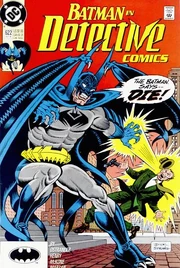
Dick Sprang's Cover
Due to the switch in creative teams, writer John Ostrander wrote a 3-part storyline in Detective Comics (issues #622- #624); which saw the return of Golden Age Batman artist, Dick Sprang, as the cover artist for the story. Afterwards, Marv Wolfman and Jim Aparo were reassigned to Detective Comics and worked together for three more issues. Both creative teams in Batman and Detective altered the status quo. In Batman #458, Grant and Breyfogle reintroduced Sarah Essen as Commissioner Gordon's romantic partner; as well as Harold Allnut as Batman's personal technician. Meanwhile, in Detective Comics, Wolfman and Aparo introduced a villain known as Abattoir and the Electrocutioner II. The two creative teams then worked in the anniversary issue of Detective; were they retold the first Batman story.
Wolfman ended his run in issue #628 of Detective Comics, after which he was followed by Peter Milligan, still with Jim Aparo as the artist. Notable elements of this run include the introduction of Blackgate Penitentiary in Detective Comics #629 and the cover illustrations, done by Michael Golden. Milligan's run came to a hiatus in issue Detective Comics #633, after which new writers and artist were brought to the title. Among them were Kelley Puckett, Jim Fern, Louise Simonson and George Pratt.
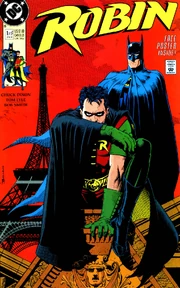
Robin's First Title
Once Tim had officially become Robin, a new 5-issue miniseries titled Robin was published, written by newcomers Chuck Dixon and Tom Lyle. The series saw Robin travel across the world to properly train for his new role, meeting new allies like Lady Shiva and new enemies like Lynx and King Snake.
Meanwhile, the Batman creative team focused on solo Batman stories featuring new and old allies like Vicki Vale, Joe Potato, Sarah Essen and Catwoman. Grant and Breyfogle then came up with a 3-part story called "Spirit of the Beast" ( #462- #464); which reintroduced Ace the Bat-Hound to the mythos. Later, they formally reintroduced the Dynamic Duo as Robin returned from his journey and joined Batman for the first time in Batman #465. Chuck Dixon and Tom Lyle temporarily became the Batman creative team and wrote "Shadow Box", a 3-part story that brought King Snake and Lynx to Gotham for the first time. When Grant and Breyfogle returned, they crafted their ususal top notch stories featuring Maxie Zeus and the return of Killer Croc, in issue #470 and #471 respectively.
Afterwards, Peter Milligan was given the chance to make a 4-part crossover storyline between Batman and Detective, with Jim Aparo and Norm Breyfogle as the artists. "The Idiot Root" became Milligan's most contrived story and also his last contribution as a regular Batman writer. "The Idiot" story took Batman out of Gotham for 4 entire issues; an absence that was taken full advantage by the team of Chuck Dixon and Tom Lyle when they created the second Robin mini-series; this time allowing Tim to confront The Joker, in their historical first encounter.

Batman on drugs
The early 90s also saw the revival of the old Batman/Superman team-up. The World's Finest series, written by Dave Gibbons and illustrated by Steve Rude was a modern take on the old concept, which attempted to reconcile the differences between the unlikely allies.
In the meantime, the spin-off series "Legends of the Dark Knight" saw the release of multiple storylines with different creative teams. Among them was the iconic Bronze Age writer Doug Moench, who returned to write Batman in the storyline called Batman: Prey, illustrated by Paul Gulacy. This story re-introduced the classic Batman villain Hugo Strange. The next storyline was Batman: Venom; by Denny O'Neil. The story introduced key concepts like the Venom drug and the island of Santa Prisca; which would be essential in later years. Venom was followed by Batman: Faith, by Mike W. Barr, which is notable for depicting the moment when Leslie Thompkins, a regular Batman ally, learned Bruce's secret identity. Afterwards came Batman: Flyer, by Howard Chaykin and Gil Kane.

"The Destroyer"
The three main Batman titles were doing fairly well, and thus came "The Destroyer". A 3-part crossover storyline between all three titles. The story is notable for introducing the art deco style and architecture design used in the 1989 Batman movie, into the Batman comics. Production designer Anton Furst produced several illustrations of landmarks in Gotham City as blueprints for other artist to replicate and this style was used primarily throughout the 90s. The story took place in Batman #474, Batman: Legends of the Dark Knight #27 and Detective Comics #641 and involved all the creative teams in those titles.
The next stories in "Legends" were Batman: Faces, a Two-Face tale by Matt Wagner marking his Batman debut; "Family", a done-in-one story by James Hudnall and Brent Anderson; and Batman: Blades, a retelling of Cavalier's origin story; written by James Robinson and illustrated by Tim Sale in his first Batman story. The first Legends Annual was also published, with Denny O'Neil teaming up with a large number of artist to create a most unique story.

The First Elseworld
With the ongoing monthly titles doing extremely well, the Batman department at DC started publishing more graphic novels and one-shot stories. Writer Mike Barr headed this new burst of creativity by creating Batman: Bride of the Demon with artist Tom Grindberg; as well as Batman: Full Circle with artist Alan Davis. Both were sequels to his previous works in Batman and their success led to more one-shots to be published. Batman: Holy Terror was published next and became the first book as part of the new DC print label called Elseworlds. The concept behind that was to tell stories about the DC characters, but set in alternate universes, different from the primary continuity, following the trend started by "Gotham by Gaslight" a few years earlier.
The new popularity also allowed DC to publish intercompany crossovers with Batman, such as Batman/Judge Dredd: Judgment on Gotham by Alan Grant, John Wagner and Simon Bisley; and later Batman versus Predator by Dave Gibbons and the Kubert brothers. The following Elseworld publications included Batman: Master of the Future, the sequel to Gotham by Gaslight and later, Batman and Dracula: Red Rain by Doug Moench and Kelley Jones; marking the first collaboration of one of the most iconic Batman creative teams.
(More to come...)
Serials
Batman (1943 Serial)
Batman first came to the Silver Screen in 1943's Batman serial, starring Lewis Wilson as Batman and Douglas Croft as Robin. J. Carrol Naish played the villain, an original character named Dr. Daka. Rounding out the cast were Shirley Patterson as Linda Page (Bruce Wayne's love interest), and William Austin as Alfred.
Batman and Robin (1949 Serial)
A second serial called Batman and Robin followed in 1949, starring Robert Lowery as Batman.
Movies
Tim Burton's Batman
Main articles: Batman (1989 Movie) and Batman Returns (Movie)

Batman in 1989
Batman returned to the big screen in director Tim Burton's Batman in 1989. The only film adaptation of the Dark Knight was the made for TV film based on the Batman TV Show from the 60s, but in the mid-80s, Warner Bros, DC Comics' parent company, talked with Tim Burton, who agreed to make a Batman movie, according to the evolution of the character.
Casting for the movie started in 1986 and even though people disliked the decision of having Michael Keaton as Batman, his performance was enough to convince even the more skeptical fans. The main antagonist of the film was the Joker, who was portrayed by Jack Nicholson and Bruce Wayne's romantic partner was Vicki Vale, portrayed by Kim Basinger. The film was a complete success as the movie was highly expected and the publicity created more enthusiasm. Burton's vision of a dark Batman living in a dark world was a drastic change from the previous portrayals of the character and it gave Batman a a new popularity in the mainstream media.
The success of the film allowed Burton to direct a sequel titled "Batman Returns", which featured new characters from the Batman mythos. Penguin was portrayed by Danny DeVito and Catwoman was portrayed by Michelle Pfeiffer. The movie, although was equally successful as the first one, had a greater shock on the audience, who found the movie polarizing; some calling it darker than the previous one and others calling it lighter. For any given reasons, Burton was not called to direct the third movie in the franchise as Warner hired Joel Schumacher to create the new Batman films.
Main articles: Batman Forever (Movie) and Batman and Robin (Movie)
The movies directed by Joel Schumacher were drastically different from that of Burton, as they appealed to the lighter side of Batman, including gadgets, costumes, vehicles and colorful villains. The franchise continued despite Keaton abandoning the main lead and for this reason Val Kilmer portrayed Batman in "Batman Forever" while George Clooney portrayed Batman in "Batman and Robin". Chris O'Donnell played Robin on both films while Jim Carrey and Tommy Lee Jones portrayed Riddler and Two-Face respectively in "Batman Forever" and Arnold Schwarzenegger and Uma Thurman played Mister Freeze and Poison Ivy. These films are considered by many some of the worst super-hero films of history and the decline on the quality of the films forced Warner to cancel any future plans to continue the franchise.
Christopher Nolan's Batman Trilogy
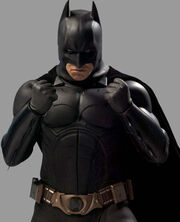
Bale as Batman in 2005
After a series of increasingly cartoonish film adaptations, the franchise was reinvigorated with a trilogy directed by Christopher Nolan. In 2005, Batman Begins was released starring Christian Bale as the Dark Knight. The main antagonists of the film were the Scarecrow and Ra's al Ghul played by Cillian Murphy and Liam Neeson. Batman Begins was the fifth live-action Batman movie since 1989 and was a reboot to the superhero's film franchise. Based on the comic storyline Batman: Year One, the film tells the origin story of the character as he takes on crime for the first time in Gotham. It is a significantly darker film, studying the character's inner struggle between justice and vengeance. It received high praise from critics and general audiences, being considered by many as the best of the series, with praise for Bale's performance.
The film is followed by a 2008 sequel, The Dark Knight. In it, Batman encounters the Joker and Two-Face portrayed by Heath Ledger and Aaron Eckhart. The Dark Knight is considered by many the best super-hero movie ever done and most of it is thanks to the outstanding performance of Ledger as the Joker. The third movie in the trilogy is The Dark Knight Rises, featuring Tom Hardy as Bane. The film was partially based on the iconic comic storylines Batman: Knightfall and Batman: No Man's Land, but it failed to reach the success of its predecessors. Nonetheless, the film was a commercial success and it marked the end of Bale and Nolan's collaboration on the Dark Knight.
Television
Batman 1966 TV Series

Batman and Robin in 1966
Batman was a thirty-minute prime time, live action television series broadcast by the ABC Network between 1966 and 1968. Premiering on January 12th, the series featured actor Adam West as the perennial character of Batman, while Burt Ward donned nylon stockings and fairy boots for his portrayal of the erstwhile sidekick, Robin.
The series took the tradition of Batman into the uncharted territory of camp, oftentimes mocking the character's heritage with trite dialogue and silly plot devices. The show was noteworthy for its memorable use of onomatopoeia during climactic fight scenes. Despite the clumsy nature of the series however, the show proved popular to many fans, and transformed Adam and Burt into modern pop culture icons. The series gained extreme heights of popularity in 1967 and 1968, until it was cancelled during its third season.
Besides the large cast of villains from the comic books used in the show, the most notable introduction was that of the Batgirl character, played by Yvonne Craig. Batgirl was a character created for the show by producer William Dozier, who then passed along the concept to Julius Schwartz, then editor of the Batman comics and Batgirl was soon included in the comics, prior to her TV debut.
Batman: The Animated Series
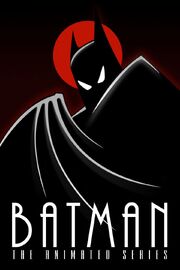
Batman
The Animated Series
Batman: The Animated Series ran from 1992 to 1999. The series was developed by Bruce Timm and Alan Burnett, basing many of the series style in the Superman cartoons from the 1940s. It was arguably a children's show, yet its dark atmosphere and award-winning writing grew a more mature fanbase. The show is based in modern-day Gotham City, a dark, gothic, crime-ridden area. The series was only made possible thanks to the success of the first Tim Burton films, from which the series drew direct influence. Among the most notable creators of the series was Paul Dini, who revamped characters like Mister Freeze and created other like Harley Quinn.
In 1994 the series was retitled The Adventures of Batman & Robin. It focused more on Robin in an attempt to appeal to children. The rename and inclusion of Robin did not adversely affect the writing and the series bowed out in September 1995 as a new version of the Batman appeared on TV.
